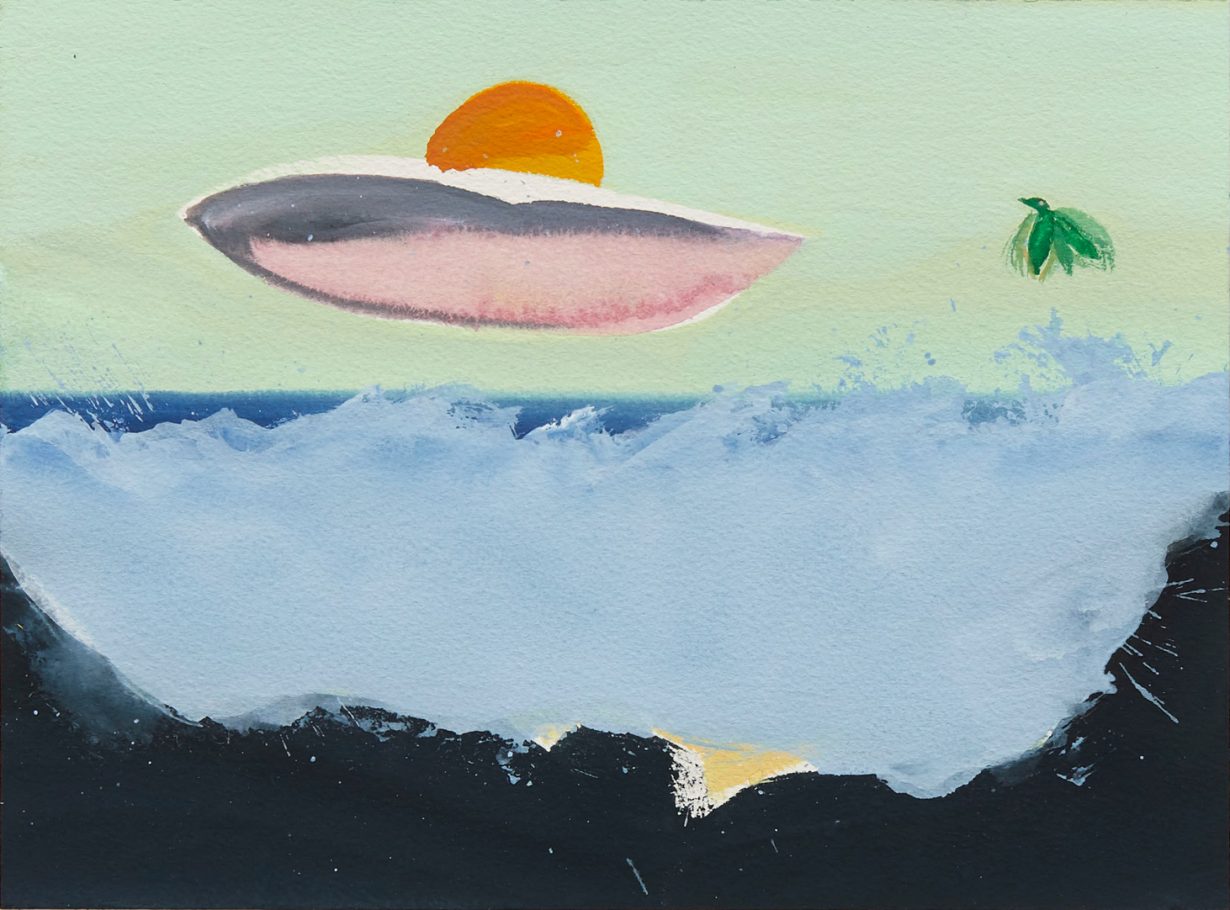
A show at ARCH, Athens presents a selection of preparatory gouaches made by the artist before he passed away last year
There is something like abandonment in the paintings of Matthew Wong. His watercolours and gouaches on paper, hung in an even ring around the elegant white cube of this nonprofit space on the fringes of Greece’s National Gardens, convey the feeling of dissolving into a landscape. Their stylised scenes are naïve – women looking out to sea, silhouettes against the sunset, deserted parasols on empty beaches – but the best of them stimulate the paradoxical experience of a fleeting moment of perfect stillness achieved through intense contemplation.
Big Wave Bay (all works 2019) is divided into two roughly equal planes by a horizon line, over which a tangerine sun is partially obscured by the solitary pink cloud in a mint-green sky. The flatness of the powder-blue and ink-black splodges representing the titular scene undermines the illusion of perspective that a horizon line naturally generates, and so the composition initially reads more like the vertical cross-section of a body of water than a window onto a receding landscape. The absence of pictorial depth – and its implication of time in the suggestion of real space – contributes to the near-ecstatic tranquillity of this breaking wave. Yet above it flutters a bird, its wings blurred as if moving too fast for the mechanics of painting to capture, and the spell is broken.

Big Wave Bay introduces the viewer into a series of fantastic landscapes imbued with so self-contained a sense of their own reality that you sometimes wish that a breeze might blow through the gallery. Pink Dawn depicts a faceless figure encircled by tree trunks that support the heavy purplish lid of a forest canopy. The dense foliage is mirrored at the bottom edge of the painting by a grey block that serves no obvious representational function but traps the composition between the jaws of a vice. A conventional image of escape – the return to nature – is recast as one of entrapment. The nightmarish distortion evokes the oppressive atmospheres found in the work of Edvard Munch, and works such as Moon Rise are so heavily indebted to the Norwegian artist’s Moonlight (1895) and Young Woman on the Beach (1896) as to suggest homage.
Indeed, it should be acknowledged that part of the initial attraction of Wong’s work is its comfortingly close resemblance to the work of artists ranging from Hokusai (Mount Fuji can be glimpsed, incongruously, behind a leafless tree) to Henri Rousseau or André Derain. Dreamlike scenes are conjured through counterintuitive fauvist colour selections and pointillist techniques. That this lack of aesthetic sophistication sometimes spills into cliché can be forgiven given that these works are introduced as preparatory works for a residency in Athens planned for this summer. That Wong died by his own hand in October last year at the age of thirty-five, shortly after completing these pieces, inevitably colours any reading of them – and lonely figures in desolate landscapes do not discourage straightforward biographical interpretation – but shouldn’t obscure their impersonation of the sublime. In standouts such as The Gloaming, the separation of colours into bright swabs and patches generates a glitter that unsettles the orders of distance that the brain tries naturally to impose on a path winding through a wooded landscape. The eye is bounced around the surface of the paper, and the particulars of the scene dissolve into an all-consuming play of colour and shape.

The sense of a solid form evanescing into the interplay of unstable elements is exaggerated by the soak of watercolour into paper. When the colour is mixed thin, bodies bleed into the landscapes around them. The effect is pantheistic, though less in the sense of the Romantic imaginary – of an electrifying life-force running like an invisible wire through all creation – than in that of the Buddhist concept of sunyata, a state of undifferentiation that underpins the purely illusory differentiation between things. The sailboat of A Voyage on the North Sea is not crushed by the waves but seems on the verge of melting into them. There is energy in these works, but it is so thoroughly diffused as to approximate perfect emptiness.
Matthew Wong: Postcards at Arch, Athens, 10 September – 11 December 2020